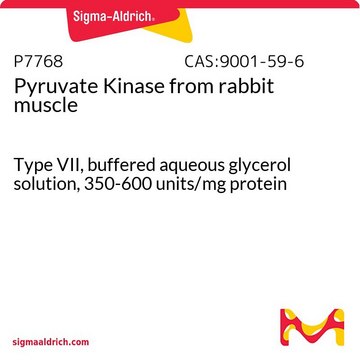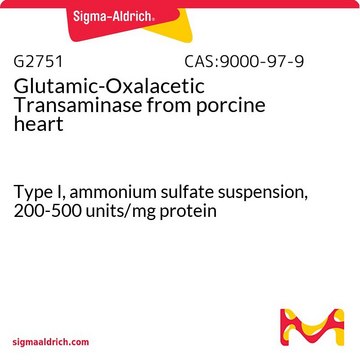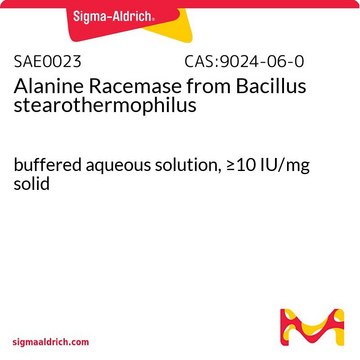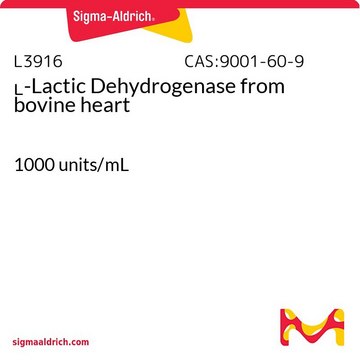L3888
D-Lactic Dehydrogenase from Lactobacillus leichmannii
lyophilized powder, 150-500 units/mg protein
Sinonimo/i:
(R)-Lactate:NAD+ oxidoreductase, D-LDH
Autenticatiper visualizzare i prezzi riservati alla tua organizzazione & contrattuali
About This Item
Prodotti consigliati
Origine biologica
bacterial (Lactobacillus leichmannii)
Livello qualitativo
Stato
lyophilized powder
Attività specifica
150-500 units/mg protein
Composizione
Protein, ~50% biuret
Attività estranea
Malic dehydrogenase <0.5% of base activity
Temperatura di conservazione
−20°C
Descrizione generale
Research area: Cell Signaling
Lactate Dehydrogenase (LDH) is classified as an oxidoreductase and is found in various organisms, including both plants and animals. LDH is widely distributed across all tissues, with high concentrations in muscle, kidney, and liver. The genes encoding LDH are LDHA, LDHB, LDHC, and LDHD. The D-isomer is produced by LDHD. There are two types of D-LDHs: NAD-dependent D-LDHs and FAD-dependent D-LDHs.
Lactate Dehydrogenase (LDH) is classified as an oxidoreductase and is found in various organisms, including both plants and animals. LDH is widely distributed across all tissues, with high concentrations in muscle, kidney, and liver. The genes encoding LDH are LDHA, LDHB, LDHC, and LDHD. The D-isomer is produced by LDHD. There are two types of D-LDHs: NAD-dependent D-LDHs and FAD-dependent D-LDHs.
Applicazioni
D-Lactic Dehydrogenase from Lactobacillus leichmannii has been used:
- in lactate dehydrogenase activity for testing the chaperone activity of proteins
- to test the kinase activities of purified thiamine monophosphate(ThiM)
- in NADH-coupled steady-state ATPase assay
- to determine cellular lactate
In the food industry, the primary catalysis is coupled to conversion of NADH and H+ to NAD+ with diaphorase coupled with converting the non-fluorescent resazurin to the highly fluorescent substance resorufin to measure the content of D-lactate in food products.
Azioni biochim/fisiol
D-lactic dehydrogenase catalyzes the conversion of pyruvate into D-lactate, with oxidation of NADH to NAD+. D-lactic dehydrogenase can also catalyze the reverse reaction, conversion of D-lactate into pyruvate with reduction of NAD+ to NADH.
It acts as a crucial checkpoint in gluconeogenesis and DNA metabolism. Elevated levels of LDH in the blood have been observed in various conditions, including heart attacks, cancers, liver disease, muscle trauma, anemia, bone fractures, and infections such as encephalitis, human immunodeficiency virus(HIV), and meningitis. LDH also serves as a non-specific marker of tissue turnover, which is a normal metabolic process. Additionally, reduced D-LDH activity has been found in case of mutations in LDHD found in patients with D-lactic acidosis.
Definizione di unità
D-lactic dehydrogenase catalyzes the conversion of pyruvate into D-lactate, with oxidation of NADH to NAD+. D-lactic dehydrogenase can also catalyze the reverse reaction, conversion of D-lactate into pyruvate with reduction of NAD+ to NADH.
One unit will reduce 1.0 μmole of pyruvate to D-lactate per min at pH 7.0 at 25 °C.
Stato fisico
Lyophilized powder containing phosphate buffer salts
Codice della classe di stoccaggio
11 - Combustible Solids
Classe di pericolosità dell'acqua (WGK)
WGK 3
Punto d’infiammabilità (°F)
Not applicable
Punto d’infiammabilità (°C)
Not applicable
Dispositivi di protezione individuale
Eyeshields, Gloves, type N95 (US)
Scegli una delle versioni più recenti:
Possiedi già questo prodotto?
I documenti relativi ai prodotti acquistati recentemente sono disponibili nell’Archivio dei documenti.
I clienti hanno visto anche
Zhaojuan Zheng et al.
Applied and environmental microbiology, 78(9), 3480-3483 (2012-02-22)
NAD-dependent l- and d-lactate dehydrogenases coexist in Lactobacillus genomes and may convert pyruvic acid into l-lactic acid and d-lactic acid, respectively. Our findings suggest that the relative catalytic efficiencies of ldhL- and ldhD-encoded products are crucial for the optical purity
Arnaud Mourier et al.
Biochimica et biophysica acta, 1777(10), 1283-1288 (2008-07-22)
Aerobically grown yeast cells express mitochondrial lactate dehydrogenases that localize to the mitochondrial inner membrane. The D-lactate dehydrogenase is a zinc-flavoprotein with high acceptor specificity for cytochrome c, that catalyzes the oxidation of D-lactate into pyruvate. In this paper, we
Andreas Neuner et al.
Biotechnology journal, 6(3), 318-329 (2011-03-04)
The Corynebacterium glutamicum ATCC 13032 lysC(fbr) strain was engineered to grow fast on racemic mixtures of lactate and to secrete lysine during growth on lactate as well as on mixtures of lactate and glucose. The wild-type C. glutamicum only grows
Takenori Shibahara et al.
Acta crystallographica. Section F, Structural biology and crystallization communications, 67(Pt 11), 1425-1427 (2011-11-22)
A dye-linked D-lactate dehydrogenase from the aerobic hyperthermophilic archaeon Aeropyrum pernix was crystallized using the hanging-drop vapour-diffusion method with polyethylene glycol 8000 as the precipitant. The crystals belonged to the monoclinic space group P2(1), with unit-cell parameters a = 63.4
Akos T Kovács et al.
Applied and environmental microbiology, 76(12), 4085-4088 (2010-04-20)
Bacillus coagulans has good potential as an industrial production organism for platform chemicals from renewable resources but has limited genetic tools available. Here, we present a targeted gene disruption system using the Cre-lox system, development of a LacZ reporter assay
Il team dei nostri ricercatori vanta grande esperienza in tutte le aree della ricerca quali Life Science, scienza dei materiali, sintesi chimica, cromatografia, discipline analitiche, ecc..
Contatta l'Assistenza Tecnica.










